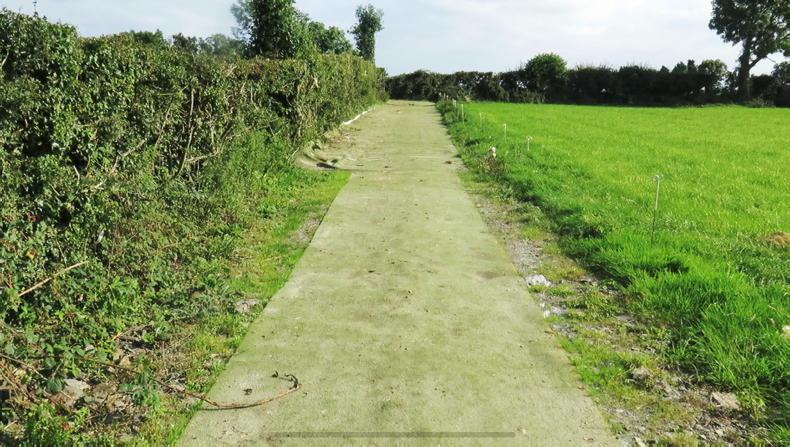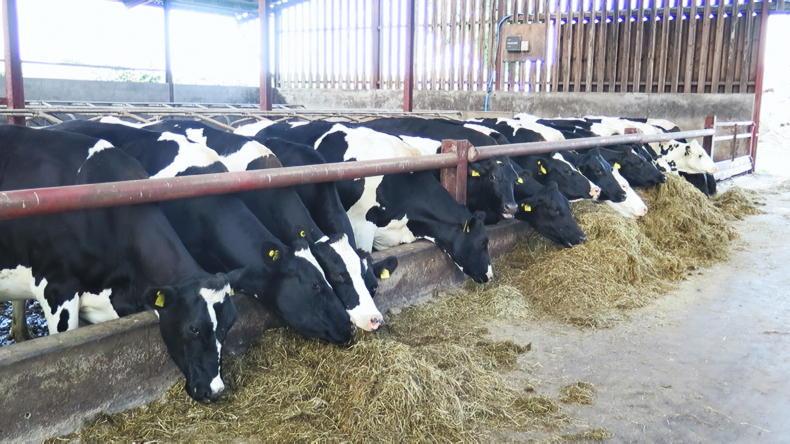The benefits of improving grassland management and tightening the calving spread were discussed at an online webinar on the Wallace farm this week.
Prior to joining the Dairylink programme, Stephen was calving cows for nine months of the year, starting in September and finishing in May.
He has put in a huge effort into fertility over the last number of years and is now reaping the rewards.
The projected calving for the coming season shows the herd is now compressed into a five month window, with 63% due to calve in September and October and 98% due to calve by the end of December.

Astroturf lined farm roadway on the Wallace farm.
“Before, I’d be going around with calving ropes in one hand and an AI rod in the other, but now things are much more streamlined,” Stephen says.
“You need to be ruthless with culling in order to get on top of it. Every farmer has their favourite cow, but I culled my favourite cow. There is a bit of pain involved in getting on top of it, but the benefits are greater,” he says.
With the tighter calving period, Stephen is improving calf rearing facilities and extra help will be drafted in also. In terms of breeding, the heifers are brought into the shed one month prior to breeding starting, so that they are fully settled and adjusted to the diet. Heat detection and AI is carried out by Genus RMS.
The vet comes every two to three weeks to scan cows, check up on any non-cyclers and hormones will be prescribed if needs be.
The herd is on track to sell over 8,000l of milk per cow, which is a rolling 12 month average and is just shy of 620kg of milk solids per cow. Meal feeding levels are higher than budgeted at 2.7t of meal per cow, but Dairylink adviser Aidan Cushnahan explained that this was largely down to the adverse grass growing conditions in the last two summers.

Close up dry cows are in good body condition score.
The Wallace farm is located near Seaforde in Co Down and is relatively dry and free draining in a low rainfall area. The farm burned up badly last July and extra meal had to be fed. The cows also ended up grazing some land that was destined for third-cut silage.
During that time, Stephen continued to measure grass and this information proved valuable when making decisions around when to introduce supplement, and just as importantly, when to stop feeding supplements.
“I wouldn’t not measure grass now. OK, it is a bit of work and sometimes you’d try to convince yourself you haven’t time to do it, but I do have better quality grass as a result and that’s carrying through into the milk constituents. If I wasn’t measuring during the dry spell, I’d have only been guessing,” Stephen says.
The implementation of a nutrient management plan has also benefited grassland management on the farm. Looking back at previous soil fertility maps, 17% of the farm was deficient in phosphorus (P), which is not a bad result, but these paddocks tended to be further away from the farmyard while the paddocks close to the yard had excess levels of P.
This was found to be a result of more slurry being spread on fields close to the yard. Since then, the low P and K fields have been targeted with extra slurry and in some cases, extra chemical phosphorus too, particularly on some hilly fields that are not suitable for slurry. Approximately half the farm has been spread with lime in recent times as a way of improving soil pH, with more lime planned to be spread before the end of the year. Stephen has been using more high calcium lime in recent years, which he spreads at a rate of 1.5t/ac.
Drying off
At this stage, there are 70 cows in the shed close to calving. They are being fed low potash haylage and 2kg per head per day of dry cow meal. There are 70 more dry cows that are far off from calving and these are out grazing, mopping up after the milking cows.
More cows are being dried off weekly and one change for this year is that Stephen is getting cows foot-trimmed as they are being dried off. About 80% of the herd will get teat sealer only at drying off.
The webinar is available to watch back on www.ifj.ie/dairylink.
A webinar on the farm of Richard and John Marshall will take place on Tuesday 14 September at 8pm on www.ifj.ie/dairylink.
The benefits of improving grassland management and tightening the calving spread were discussed at an online webinar on the Wallace farm this week.
Prior to joining the Dairylink programme, Stephen was calving cows for nine months of the year, starting in September and finishing in May.
He has put in a huge effort into fertility over the last number of years and is now reaping the rewards.
The projected calving for the coming season shows the herd is now compressed into a five month window, with 63% due to calve in September and October and 98% due to calve by the end of December.

Astroturf lined farm roadway on the Wallace farm.
“Before, I’d be going around with calving ropes in one hand and an AI rod in the other, but now things are much more streamlined,” Stephen says.
“You need to be ruthless with culling in order to get on top of it. Every farmer has their favourite cow, but I culled my favourite cow. There is a bit of pain involved in getting on top of it, but the benefits are greater,” he says.
With the tighter calving period, Stephen is improving calf rearing facilities and extra help will be drafted in also. In terms of breeding, the heifers are brought into the shed one month prior to breeding starting, so that they are fully settled and adjusted to the diet. Heat detection and AI is carried out by Genus RMS.
The vet comes every two to three weeks to scan cows, check up on any non-cyclers and hormones will be prescribed if needs be.
The herd is on track to sell over 8,000l of milk per cow, which is a rolling 12 month average and is just shy of 620kg of milk solids per cow. Meal feeding levels are higher than budgeted at 2.7t of meal per cow, but Dairylink adviser Aidan Cushnahan explained that this was largely down to the adverse grass growing conditions in the last two summers.

Close up dry cows are in good body condition score.
The Wallace farm is located near Seaforde in Co Down and is relatively dry and free draining in a low rainfall area. The farm burned up badly last July and extra meal had to be fed. The cows also ended up grazing some land that was destined for third-cut silage.
During that time, Stephen continued to measure grass and this information proved valuable when making decisions around when to introduce supplement, and just as importantly, when to stop feeding supplements.
“I wouldn’t not measure grass now. OK, it is a bit of work and sometimes you’d try to convince yourself you haven’t time to do it, but I do have better quality grass as a result and that’s carrying through into the milk constituents. If I wasn’t measuring during the dry spell, I’d have only been guessing,” Stephen says.
The implementation of a nutrient management plan has also benefited grassland management on the farm. Looking back at previous soil fertility maps, 17% of the farm was deficient in phosphorus (P), which is not a bad result, but these paddocks tended to be further away from the farmyard while the paddocks close to the yard had excess levels of P.
This was found to be a result of more slurry being spread on fields close to the yard. Since then, the low P and K fields have been targeted with extra slurry and in some cases, extra chemical phosphorus too, particularly on some hilly fields that are not suitable for slurry. Approximately half the farm has been spread with lime in recent times as a way of improving soil pH, with more lime planned to be spread before the end of the year. Stephen has been using more high calcium lime in recent years, which he spreads at a rate of 1.5t/ac.
Drying off
At this stage, there are 70 cows in the shed close to calving. They are being fed low potash haylage and 2kg per head per day of dry cow meal. There are 70 more dry cows that are far off from calving and these are out grazing, mopping up after the milking cows.
More cows are being dried off weekly and one change for this year is that Stephen is getting cows foot-trimmed as they are being dried off. About 80% of the herd will get teat sealer only at drying off.
The webinar is available to watch back on www.ifj.ie/dairylink.
A webinar on the farm of Richard and John Marshall will take place on Tuesday 14 September at 8pm on www.ifj.ie/dairylink.









 This is a subscriber-only article
This is a subscriber-only article










SHARING OPTIONS: